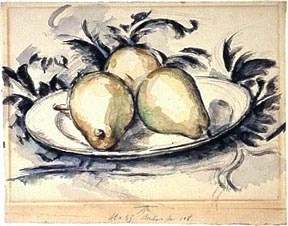|
News from For immediate release: Oct. 19, 2002
CONTACT: Ruta Smithson (609) 258-3763 Special Exhibition to Focus on Cézanne at Princeton University Art MuseumExhibition Dates: October 19, 2002, through January 12, 2003
PRINCETON—Despite Paul Cézanne’s apparently fine disregard for his watercolors—which he is said to have discarded, or stacked haphazardly in his studio—over six hundred of these delicate and translucent works on paper have survived. This number includes the sixteen outstanding examples featured in the exhibition “Cézanne in Focus: Watercolors from the Henry and Rose Pearlman Collection,” which will open at the Princeton University Art Museum on Saturday, October 19, and remain on view through January 12, 2003. On loan to the museum since 1976 but rarely shown due to their sensitivity to light, this small yet extraordinary group is considered to be one of the finest assemblies of Cézanne watercolors anywhere. The Pearlman collection was begun in the 1940s by Henry Pearlman, a self-described “worshipper of Cézanne,” who accumulated thirty-three works (including paintings, drawings, and prints) by the Provençal master. Spanning Cézanne’s entire career, these watercolors consist primarily of landscapes, as well as several still lifes (including one of his most austere skull images), and an early scene from Virgil’s Aeneid. The landscapes include frequently depicted Provençal motifs such as Mont Sainte-Victoire, the park of Château Noir, and the Bibémus rock quarry, as well as Cézanne’s only known representation of Aix-en Provence, Fountain in the Place de La Mairie. The still lifes range from the early, sensual Three Pears, which Edgar Degas purchased at Cézanne’s one-man show in 1895, to the monumental and atmospheric Still Life with Carafe, Bottle, and Fruit, executed shortly before his death in 1906. Complementing these works in the exhibition are related paintings and drawings by Cézanne from the Pearlman collection, as well as a sketchbook page lent by the Philadelphia Museum of Art. Intimate in scale and presentation, the exhibition invites the spectator to study Cézanne’s complicated watercolor technique, and to participate in the artist’s shifting and probing perception of a single motif, which he described as being “so varied that I believe I could keep busy for months without changing position but by leaning a little to the right and then to the left.” Organized by Laura M. Giles, associate curator of prints and drawings, this exhibition celebrates the publication of the first scholarly catalogue on these watercolors. Focusing on the unique interplay between painting and drawing, which is integral to an understanding of Cézanne’s work as a whole, the catalogue includes introductory essays by Matthew Simms, assistant professor of art history at Emory University, and Faith Zieske, conservator of works on paper at the Philadelphia Museum of Art, and in-depth entries by graduate students in the Department of Art and Archaeology at Princeton University. Providing the dual perspectives of art history and paper conservation, this publication represents a major addition to the field of Cézanne scholarship. The 136-page catalogue, which is fully illustrated in color, is $30.00 and is available at the Museum Shop. It can be ordered through the museum website, princetonartmuseum.org, or by calling the Publications Office at (609) 258-5203. An auxiliary exhibition, “Earth’s Beauty Revealed: The Nineteenth-Century European Landscape,” has been organized in conjunction with the Cézanne exhibition as well as a variety of educational programs, which are made possible by the Friends of the Princeton University Art Museum.
Performance Daniel Rothman's Cézanne's Doubt is a chamber opera for solo voice, clarinet, trumpet, cello, and audio and video processing. The text, also by Rothman, is based on Cézanne’s letters and one of the painter’s favorite poems, Baudelaire's Une Charogne. The performers are Richard Lalli (voice), David Smeyers (clarinet), Wadada Leo Smith (trumpet), Ted Mook (cello), and Kent Clelland (electronics) with video processing and projection by Elliot Anderson and Jim Campbell. Tickets are $10 general admission, and free for Friends of the Princeton University Art Museum, faculty, and students. Tickets will be available beginning October 1, by calling (609) 258-1742. For more information call (609) 258-7482 or visit the museum website: www.princetonartmuseum.org. Film Gallery Talks Lecture Gallery Talk
|
||||
| top |
